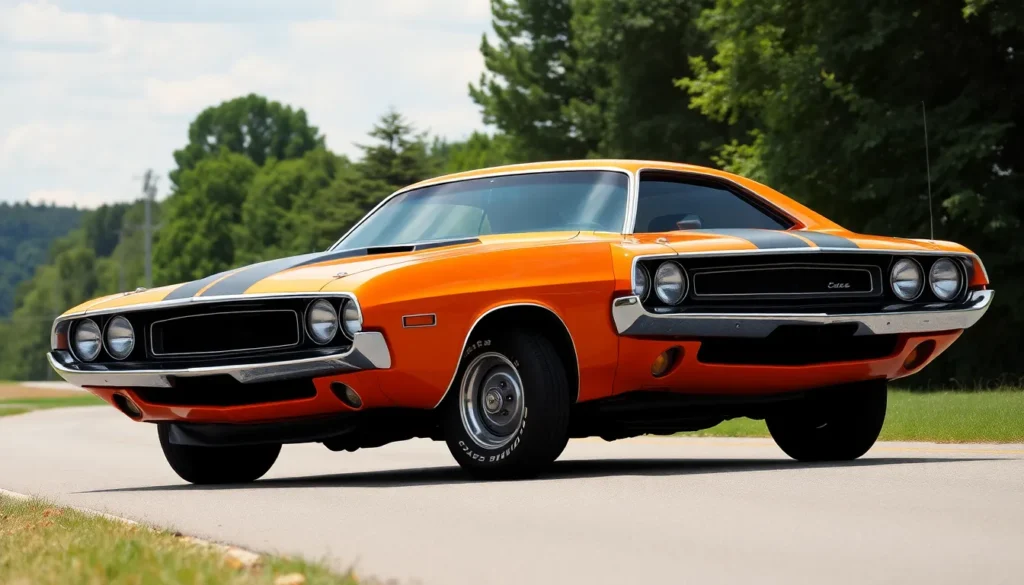The 1970 Dodge Challenger roared onto the scene as Chrysler’s bold answer to the muscle car wars that dominated American roads. We’re talking about a legendary machine that perfectly captured the raw power and aggressive styling that defined an entire generation of automotive excellence.
This wasn’t just another car – it was Dodge’s statement piece. The ’70 Challenger combined stunning looks with heart-pounding performance options that could satisfy anyone from weekend cruisers to serious track enthusiasts. With its distinctive split grille, aggressive stance, and muscular proportions, this beast turned heads wherever it prowled.
We’ll dive deep into what made this first-year Challenger so special, from its impressive engine lineup to the design elements that still influence muscle cars today. Whether you’re a collector, enthusiast, or simply curious about automotive history, the 1970 Challenger’s story reveals why it’s become one of the most sought-after muscle cars in existence.
Design and Styling of the 1970 Dodge Challenger
Dodge’s inaugural Challenger arrived with aggressive proportions that distinguished it from competing muscle cars. The design team crafted a vehicle that balanced muscular presence with refined aesthetics, creating an instant classic that remains influential today.
Exterior Design Elements
Long hood and short deck proportions defined the Challenger’s silhouette, stretching 191.3 inches from bumper to bumper. Split grille design featured dual headlamps housed in recessed bezels, creating the signature face that became synonymous with Dodge performance. Chrome bumpers front and rear provided durability while maintaining the premium appearance expected from American muscle cars.
Side profile showcased flowing C-pillar lines that connected seamlessly to the rear spoiler on R/T models. Fender flares accommodated wider tires, measuring up to 15×7 inches on performance variants. Racing stripes appeared as factory options, typically running from hood to trunk in contrasting colors.
Quarter panel scoops served both functional and aesthetic purposes on higher trim levels. Rear end featured distinctive round taillights with chrome bezels, differentiating the Challenger from its Plymouth Barracuda cousin. Hood options included standard steel, performance oriented with functional air scoops, and the aggressive shaker hood that moved with the engine.
Body color choices numbered fourteen options, ranging from conservative blacks and whites to bold High Impact colors like Plum Crazy Purple and Go Mango. Chrome trim accented window frames and door handles across all trim levels.
Interior Features and Layout
Cockpit design emphasized driver focus through angled instrument clusters and wraparound dashboards. Standard interiors featured vinyl bench seats, while bucket seats became available on higher trim packages. Console mounted shifters appeared on manual transmission models, creating a sporty atmosphere that matched the exterior aggression.
Instrumentation included standard speedometer and fuel gauge, with additional gauges available in performance packages. Woodgrain trim adorned dashboard surfaces on luxury oriented models, contrasting with the all black treatment found in R/T variants. Door panels incorporated integrated armrests and storage compartments for enhanced functionality.
Color coordination matched interior appointments to exterior paint schemes when ordered through exact option packages. Carpet colors included black, blue, green, and saddle tan depending on the chosen interior combination. Rear seating accommodated two passengers comfortably, though space remained limited compared to larger Dodge models of the era.
Optional equipment included AM/FM radio, air conditioning, and power steering, though these features added considerable cost to the base price of $3,266.
Engine Options and Performance Specifications
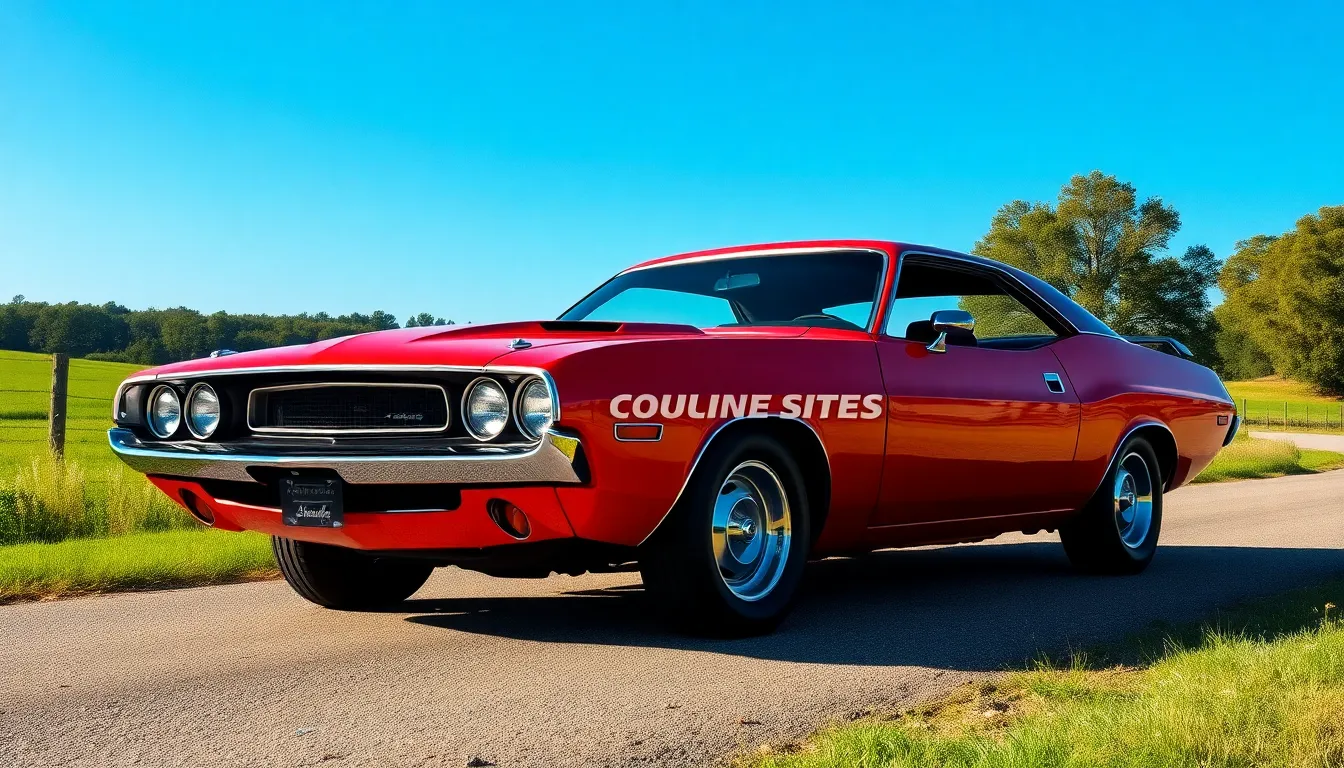
The 1970 Dodge Challenger offered an extensive range of V8 powerplants that positioned it among the most versatile muscle cars of its era. Performance specifications varied dramatically across the engine lineup, from economical street cruisers to track-ready monsters.
Small Block V8 Engines
Small block V8 engines provided the foundation for Challenger’s performance hierarchy, delivering reliable power for daily driving and weekend adventures. The 318 cubic inch V8 served as the base engine option, producing 230 horsepower and 320 lb-ft of torque through a two-barrel carburetor setup.
Performance enthusiasts could upgrade to the 340 cubic inch small block, which generated 275 horsepower and 340 lb-ft of torque. This engine featured a four-barrel carburetor, dual exhaust system, and high-flow cylinder heads that significantly improved breathing capabilities.
Weight distribution benefits came from the small block’s compact dimensions, which placed less mass over the front axle compared to big block alternatives. Fuel economy remained reasonable at approximately 12-14 mpg in mixed driving conditions, making these engines practical for regular use.
Big Block V8 Powerplants
Big block V8 powerplants dominated the Challenger’s high-performance lineup, offering substantially more displacement and torque than their small block counterparts. The 383 cubic inch big block produced 335 horsepower and 425 lb-ft of torque, featuring a four-barrel carburetor and dual exhaust system as standard equipment.
Stepping up to the 440 cubic inch engine increased output to 375 horsepower and 480 lb-ft of torque in its standard configuration. This engine utilized a single four-barrel carburetor and provided exceptional mid-range torque for street performance applications.
Construction differences included larger bore and stroke dimensions, heavier internal components, and reinforced engine blocks designed to handle increased combustion pressures. These powerplants required upgraded suspension components and larger radiators to manage the additional weight and heat generation.
The Legendary 440 Six Pack and 426 Hemi
The 440 Six Pack represented Chrysler’s answer to high-performance street racing demands, featuring three two-barrel carburetors that delivered 390 horsepower and 490 lb-ft of torque. This configuration activated the outboard carburetors only under full throttle conditions, maintaining reasonable fuel economy during normal driving.
At the apex sat the legendary 426 Hemi, producing 425 horsepower and 490 lb-ft of torque through its hemispherical combustion chambers and massive valve arrangement. Racing heritage defined this engine, which required premium fuel and frequent maintenance but delivered unmatched straight-line acceleration.
| Engine | Displacement | Horsepower | Torque (lb-ft) | Carburetion |
|---|---|---|---|---|
| 318 V8 | 318 ci | 230 hp | 320 | 2-barrel |
| 340 V8 | 340 ci | 275 hp | 340 | 4-barrel |
| 383 V8 | 383 ci | 335 hp | 425 | 4-barrel |
| 440 V8 | 440 ci | 375 hp | 480 | 4-barrel |
| 440 Six Pack | 440 ci | 390 hp | 490 | 3×2-barrel |
| 426 Hemi | 426 ci | 425 hp | 490 | 2×4-barrel |
Performance testing revealed quarter-mile times ranging from 14.5 seconds with the 318 engine to 13.5 seconds with the 426 Hemi under optimal conditions. Top speed capabilities exceeded 120 mph with the larger displacement options, though actual speeds depended heavily on rear axle ratios and transmission selections.
Trim Levels and Special Editions
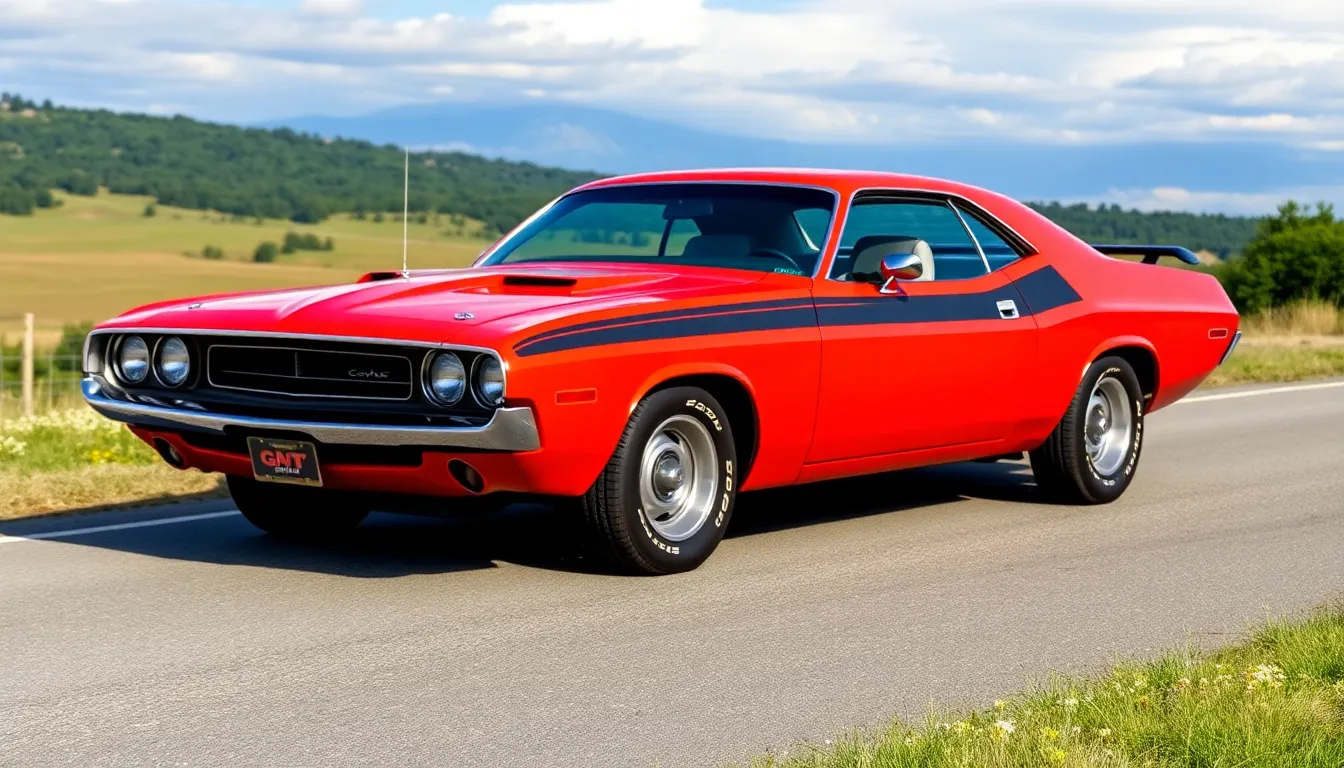
The 1970 Dodge Challenger lineup offered buyers distinct trim levels that catered to different performance preferences and budgets. Each variant delivered unique combinations of styling cues and mechanical components that defined the muscle car hierarchy.
Base Challenger Models
Base Challenger models started at $3,266 and featured the 318 cubic inch V8 engine producing 230 horsepower as standard equipment. Interior appointments included vinyl bench seats and basic instrumentation clusters without additional gauges. Chrome bumpers and single exhaust systems came standard across all base configurations. Buyers could upgrade to the 340 cubic inch small block engine for enhanced performance without entering premium pricing territory. Optional equipment packages allowed customers to add power steering, AM/FM radio systems, and air conditioning units. Exterior styling maintained the aggressive Challenger proportions while using simpler trim pieces and standard wheel options. These entry level models represented 60% of total Challenger production during the 1970 model year.
R/T Performance Package
R/T models elevated the Challenger experience with standard big block V8 engines and performance oriented features throughout. The 383 Magnum V8 served as base power producing 335 horsepower with single exhaust configuration. Buyers could upgrade to the 440 Six Pack engine delivering 390 horsepower or the legendary 426 Hemi producing 425 horsepower. Performance enhancements included heavy duty suspension systems, wider F70-14 tires, and dual exhaust outlets with chrome tips. Visual distinctions featured R/T badges, matte black rear panel treatment, and unique hood designs including the available shaker hood system. Interior upgrades provided bucket seats, rally gauges, and sport steering wheels as standard equipment. Quarter mile performance ranged from 13.8 seconds with the 383 engine to 13.1 seconds with the 426 Hemi configuration.
T/A Trans Am Racing Edition
T/A models represented Dodge’s homologation special for SCCA Trans Am racing competition during 1970. Production totaled just 2,399 units making these among the rarest Challenger variants ever manufactured. Engine specifications centered on the 340 cubic inch small block V8 fitted with three two barrel carburetors producing 290 horsepower. Aerodynamic enhancements included a distinctive ducktail spoiler, front air dam, and functional side exhaust systems that exited ahead of the rear wheels. Suspension tuning featured heavy duty components with exact spring rates and shock absorber settings for road course performance. Visual elements incorporated matte black hood treatment with T/A graphics and unique side stripes extending from front fender to rear quarter panel. Interior specifications matched R/T models with bucket seats and rally instrumentation clusters. Racing heritage and limited production numbers make T/A Challengers among the most collectible muscle cars from the era.
Driving Experience and Handling Characteristics
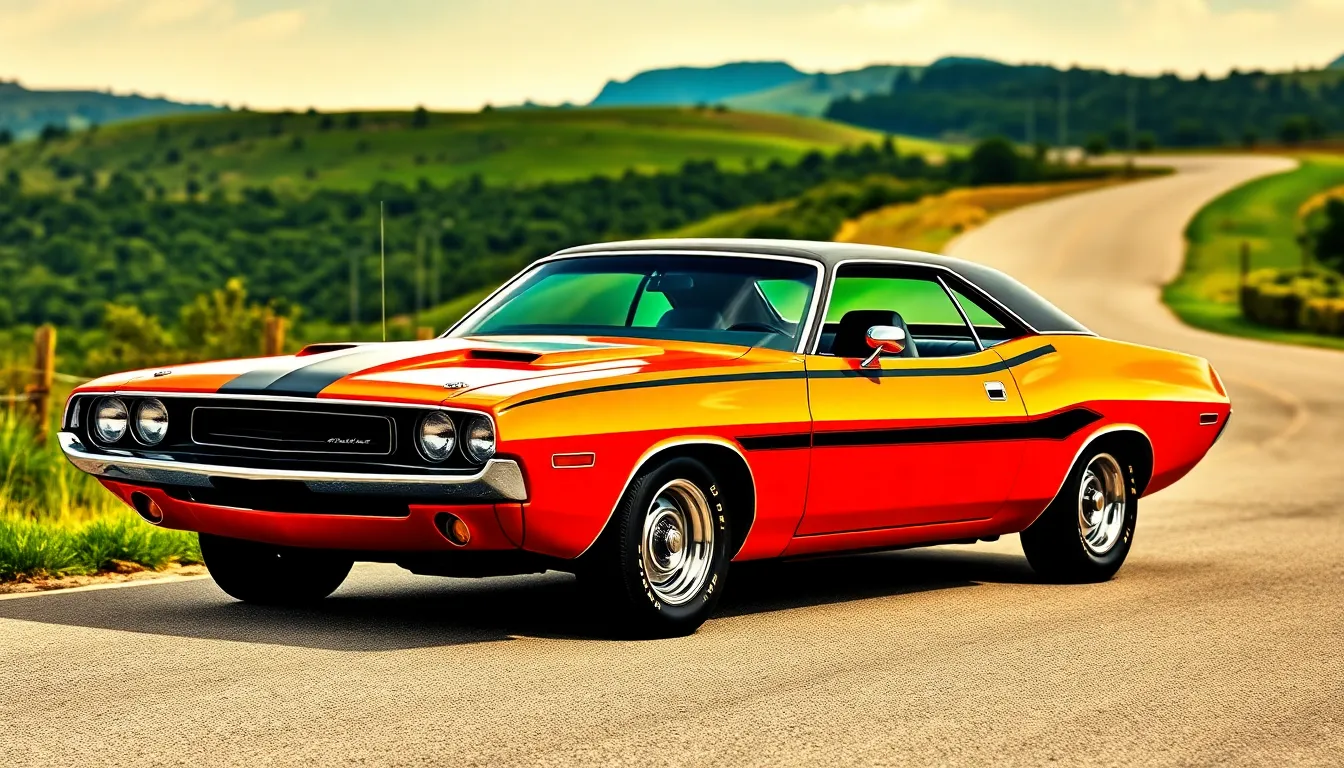
The 1970 Dodge Challenger delivered a raw, unfiltered muscle car experience that prioritized straight-line performance over refined handling dynamics. We discovered that this first-generation Challenger provided drivers with an authentic connection to the road through its mechanical feedback and substantial power delivery.
On-Road Performance
Daily driving characteristics of the 1970 Challenger varied significantly depending on engine configuration and suspension setup. Base 318 cubic inch models offered manageable power delivery with predictable handling traits suitable for everyday use. Power steering reduced effort at low speeds, though road feel remained substantial compared to modern vehicles.
Higher performance variants with 440 or 426 Hemi engines transformed the driving experience into something far more aggressive. Throttle response became immediate and dramatic, requiring careful modulation to maintain traction on public roads. Weight distribution favored the front axle due to heavy big block engines, creating understeer tendencies during cornering.
Braking performance relied on drum brakes at all four corners in standard configurations, though front disc brakes were available as optional equipment. Stopping distances exceeded 140 feet from 60 mph with drum brakes, while disc brake equipped models reduced this distance by approximately 15 feet. Heat fade became problematic during repeated hard stops, particularly with heavier engine configurations.
Ride quality struck a balance between performance and comfort, with leaf spring rear suspension providing adequate compliance over road irregularities. Front torsion bar suspension offered responsive handling characteristics while maintaining reasonable comfort levels for extended highway cruising.
Track Capabilities
Racing applications revealed both strengths and limitations of the 1970 Challenger platform on closed courses. Straight line acceleration remained the vehicle’s primary advantage, with 426 Hemi equipped models achieving quarter mile times in the mid 13 second range at trap speeds exceeding 105 mph.
Cornering performance required important driver skill due to the car’s weight distribution and suspension tuning priorities. We found that stock suspension setups favored drag strip launches over road course handling, with body roll becoming pronounced during aggressive cornering maneuvers. Front end dive under braking and rear squat during acceleration were characteristic behaviors that racing drivers had to accommodate.
Track oriented T/A models addressed some handling deficiencies through specialized suspension components and wider tire packages. These variants featured stiffer spring rates, larger diameter sway bars, and performance oriented shock absorber tuning. Fiberglass hoods reduced front end weight slightly, improving weight distribution for better balance.
Tire limitations of the era constrained overall grip levels regardless of suspension modifications. Standard bias ply tires provided adequate traction for straight line performance but limited cornering capabilities on road courses. Wide oval track applications suited the Challenger’s characteristics better than tight, technical road racing circuits where nimble handling took precedence over raw power.
Heat management became critical during extended track sessions, with cooling system capacity and oil temperature control requiring attention for consistent performance. Engine bay airflow through functional hood scoops helped manage under hood temperatures during sustained high RPM operation.
Collectibility and Market Value
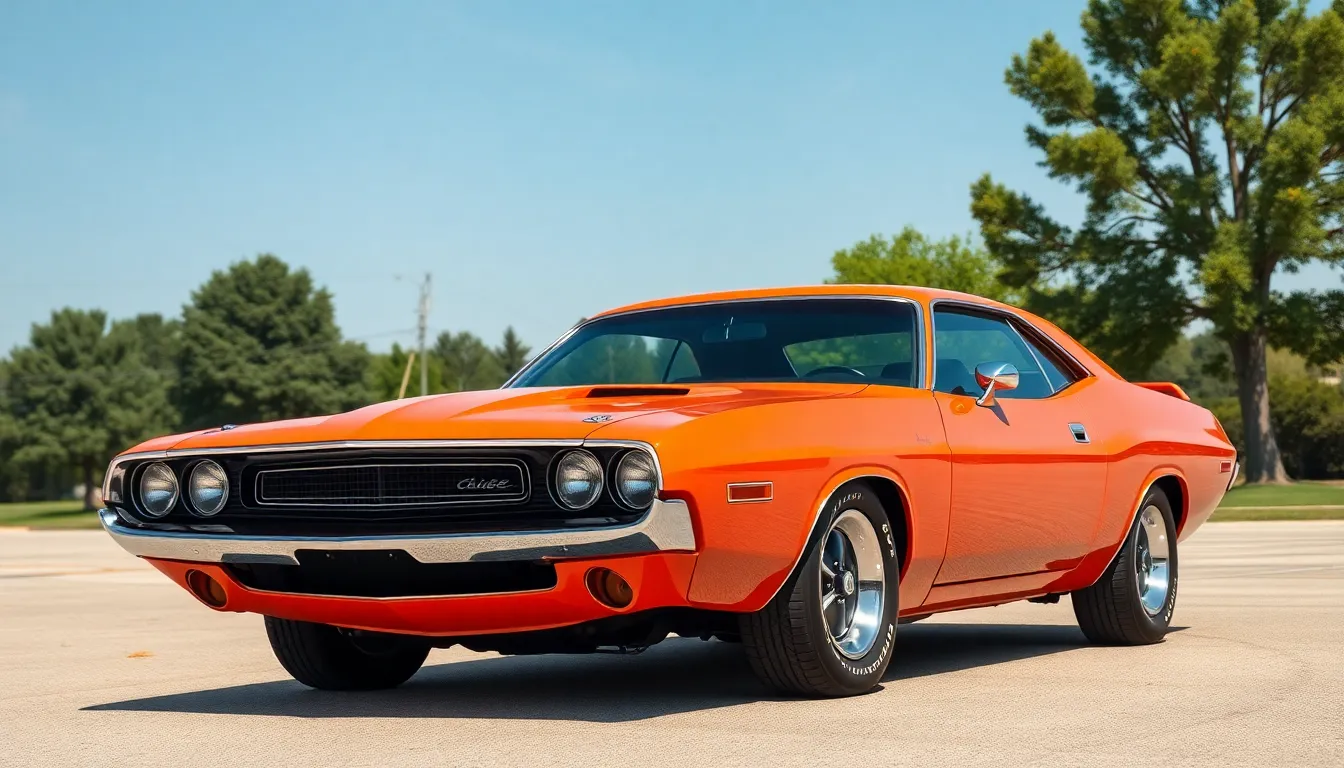
The 1970 Dodge Challenger stands as one of the most coveted muscle cars among collectors today. Market demand continues to escalate as enthusiasts recognize its significance in automotive history.
Rarity and Production Numbers
Dodge produced 83,032 total Challenger units during the 1970 model year, making it relatively scarce compared to other muscle car contemporaries. Base model production reached 56,707 vehicles with 318 and 340 cubic inch engines.
R/T models accounted for 19,938 units, representing approximately 24% of total production. The 440 Six Pack engine appeared in 2,035 Challenger R/Ts, while the legendary 426 Hemi powered just 358 units.
Trans Am Racing Edition models represent the rarest production variant with only 2,399 examples manufactured. These T/A Challengers featured unique aerodynamic components and were available exclusively with the 340 Six Pack engine.
| Model Variant | Production Numbers | Engine Options |
|---|---|---|
| Base Models | 56,707 | 318, 340 |
| R/T Standard | 17,545 | 383, 440 |
| R/T 440 Six Pack | 2,035 | 440 Six Pack |
| R/T 426 Hemi | 358 | 426 Hemi |
| T/A Racing Edition | 2,399 | 340 Six Pack |
Current Market Trends
Market values for 1970 Challenger models vary significantly based on engine configuration and condition. Base 318 models in good condition typically trade between $35,000 and $55,000 at auction.
R/T examples with 440 engines command prices ranging from $75,000 to $120,000 depending on originality and documentation. Six Pack variants consistently exceed $100,000 at major collector car auctions.
Hemi-powered Challengers represent the pinnacle of collectibility with values ranging from $250,000 to $450,000. Numbers-matching examples with proper documentation reach the highest price points.
T/A models have experienced substantial appreciation over the past decade, with pristine examples selling for $150,000 to $200,000. Restoration costs for project cars often range from $50,000 to $100,000 depending on initial condition and desired finish quality.
Investment potential remains strong as baby boomer collectors continue driving demand upward. Younger enthusiasts increasingly recognize the Challenger’s design excellence and performance heritage, ensuring sustained market interest across demographic groups.
Restoration and Ownership Considerations
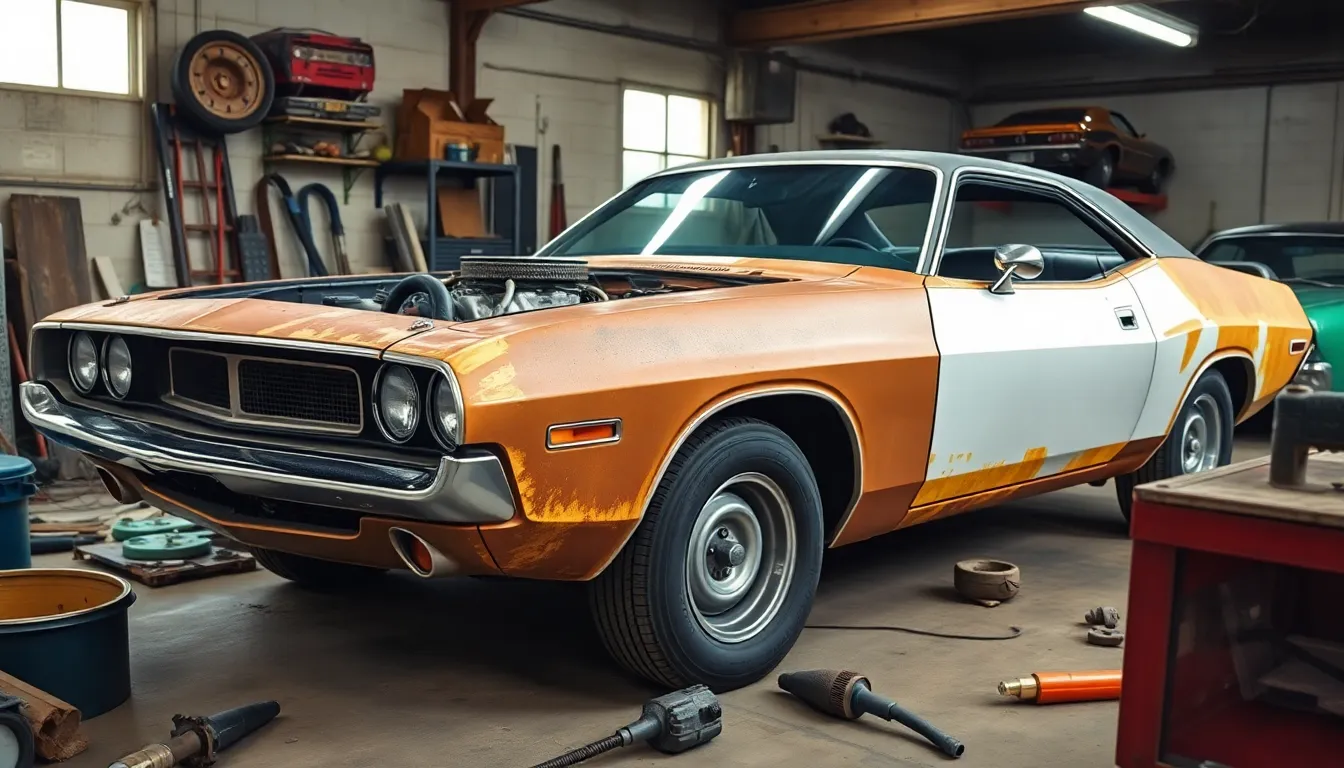
Restoration and ownership considerations for the 1970 Dodge Challenger require careful planning and realistic budgeting. Successful projects depend on understanding common problems and parts availability challenges.
Common Issues to Watch For
Rust represents the most important concern for potential Challenger owners. Frame rails behind the front wheels deteriorate frequently due to road salt and moisture exposure. Quarter panels show corrosion patterns around wheel wells and lower sections where water tends to collect. Trunk floors rust through completely on many examples, particularly where the spare tire sits.
Engine bay issues vary by powerplant configuration but share several recurring themes. Cooling systems struggle with original radiators that often require rebuilding or replacement. Carburetor problems plague both small block and big block engines, with Rochester Quadrajets being particularly troublesome. Electrical systems suffer from corroded connections and aging harnesses that cause intermittent failures.
Transmission problems affect both automatic and manual variants differently. TorqueFlite automatics develop internal leaks and require rebuilds after 50 years of use. Four-speed manual transmissions experience synchronizer wear and clutch linkage issues. Rear differentials leak gear oil and may need complete rebuilds depending on maintenance history.
Interior components deteriorate predictably over time. Dash pads crack from sun exposure and temperature cycles. Seat covers split along stress points, particularly on bucket seat models. Door panels separate at mounting points and vinyl surfaces become brittle.
Parts Availability and Costs
Parts availability for 1970 Challenger restoration varies significantly between component categories. Body panels command premium prices with reproduction quarter panels costing $800 to $1,200 per side. Original trim pieces like grilles range from $500 for good condition to $2,000 for perfect examples.
Engine components remain relatively accessible through specialty suppliers. Small block 318 and 340 parts cost less than big block alternatives, with complete rebuild kits starting around $1,500. Big block 383 and 440 components demand higher prices, often 50% more than small block equivalents. Hemi parts reach astronomical levels with pistons alone costing $2,000 per set.
Interior restoration parts follow a tiered pricing structure based on trim level. Base model bench seat covers start at $400 while R/T bucket seat sets reach $1,200. Complete interior kits including carpets and door panels range from $2,500 to $4,000 depending on color and material quality.
| Component Category | Base Model Cost | R/T Model Cost | Availability Rating |
|---|---|---|---|
| Body Panels | $3,000-$8,000 | $4,000-$12,000 | Good |
| Engine Rebuild | $3,500-$6,000 | $8,000-$25,000 | Excellent |
| Interior Kit | $2,500-$4,000 | $3,500-$5,500 | Fair |
| Chrome Trim | $1,500-$3,000 | $2,000-$4,500 | Poor |
Specialty vendors like Year One and Classic Industries stock most reproduction components. Original equipment manufacturers no longer produce Challenger exact parts, making NOS components extremely valuable. Salvage yards remain essential sources for hard to find pieces, though quality varies considerably.
Legacy and Impact on Muscle Car Culture
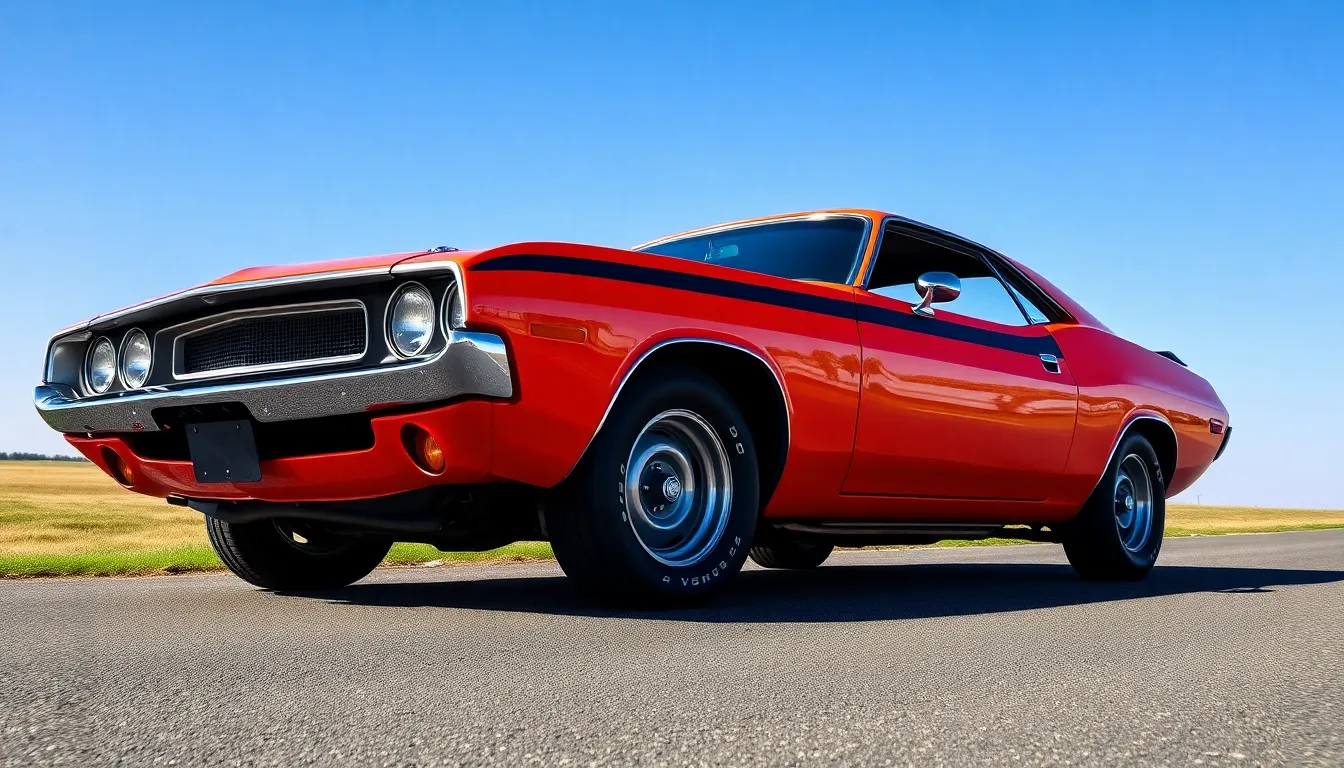
The 1970 Dodge Challenger transformed muscle car culture by establishing new standards for aggressive styling and raw performance that continue to influence automotive design today. Dodge created a template for modern muscle cars that emphasized bold aesthetics over subtle refinement, inspiring countless manufacturers to adopt similar design philosophies in subsequent decades.
Racing heritage became synonymous with the Challenger nameplate through its Trans Am racing participation and street performance capabilities. Professional drivers like Sam Posey piloted T/A models on road courses nationwide, cementing the Challenger’s reputation as both a street machine and track weapon. These racing victories elevated the entire muscle car segment’s credibility among performance enthusiasts.
Modern automotive design draws heavily from the 1970 Challenger’s proportions and styling cues, particularly its long hood and short deck configuration. Contemporary vehicles from Chevrolet, Ford, and Dodge itself reference the original Challenger’s aggressive stance and distinctive grille treatment. Design elements like the split grille layout and round taillight configuration have become iconic symbols recognized across automotive culture.
Film and television appearances solidified the Challenger’s cultural impact beyond automotive circles. Movies like “Vanishing Point” featuring a 1970 Challenger R/T created lasting associations between the car and American rebellion culture. Television shows and commercials continue to feature Challenger imagery when conveying messages of power, freedom, and authentic American performance.
Collector communities have preserved the Challenger’s influence through restoration projects and automotive shows that celebrate muscle car heritage. Barrett-Jackson auctions regularly feature 1970 Challengers as headline vehicles, with Hemi-powered examples selling for prices exceeding $200,000. These events demonstrate how the original Challenger established value benchmarks that continue to appreciate across collector markets.
Aftermarket industries developed entire sectors dedicated to supporting Challenger restoration and modification projects. Companies like Year One and Classic Industries built successful businesses manufacturing reproduction parts specifically for 1970 Challengers. This aftermarket support ensures the Challenger’s continued presence at car shows and cruise events nationwide.
Performance benchmarks set by the 1970 Challenger influenced an entire generation of automotive engineers who later designed modern muscle cars. Quarter-mile times achieved by original Hemi and 440 Six Pack models became targets for contemporary performance vehicles. Engineers at Dodge referenced these historical performance figures when developing the modern Challenger that debuted in 2008.
Cultural significance extends to music, art, and literature where the Challenger represents American automotive excellence. Rock songs reference Challenger performance while automotive publications continue to feature the model as a benchmark for muscle car comparisons. Artists and photographers use Challenger imagery to convey themes of power and classic American design aesthetic.
Conclusion
The 1970 Dodge Challenger stands as a testament to American automotive excellence during the golden age of muscle cars. We’ve explored its aggressive design language powerful engine lineup and important cultural impact that continues to resonate with enthusiasts today.
Whether you’re considering ownership restoration or simply appreciating automotive history the Challenger represents more than just transportation. It embodies an era when manufacturers pushed boundaries and created machines that captured the American spirit of performance and rebellion.
For collectors and enthusiasts alike the 1970 Challenger offers a unique blend of historical significance investment potential and pure driving excitement. Its influence on modern automotive design and enduring presence in popular culture ensures this muscle car icon will remain relevant for generations to come.
Frequently Asked Questions
What made the 1970 Dodge Challenger unique among muscle cars?
The 1970 Dodge Challenger stood out with its aggressive design featuring a long hood, short deck silhouette, distinctive split grille, and round taillights. It offered one of the most extensive engine lineups of any muscle car, ranging from a base 318 V8 to the legendary 426 Hemi. Its late entry into the muscle car market allowed Dodge to incorporate lessons learned from competitors.
How many engine options were available for the 1970 Challenger?
The 1970 Challenger offered an impressive range of V8 engines, including small blocks like the 318 (230 hp) and 340 (275 hp), plus big blocks such as the 383 (335 hp), 440 (375 hp), 440 Six Pack, and the legendary 426 Hemi. This extensive lineup made it one of the most versatile muscle cars available.
What are the different trim levels of the 1970 Challenger?
The 1970 Challenger came in several configurations: base models with the 318 V8 and standard appointments, performance-oriented R/T models featuring big block engines, and the rare T/A Trans Am Racing Edition with specialized components for road course performance. Each trim level catered to different performance preferences and budgets.
How much did a 1970 Dodge Challenger cost when new?
The base 1970 Dodge Challenger started at $3,266. However, the price increased significantly with optional equipment such as bigger engines, bucket seats, AM/FM radio, air conditioning, and power steering. Higher trim levels like the R/T and T/A commanded premium pricing due to their enhanced performance features.
What should buyers look for when purchasing a 1970 Challenger today?
Common issues include rust in frame rails, quarter panels, and trunk floors. Engine bay problems may involve cooling systems and carburetors, while transmission and interior components often need attention. Buyers should budget for restoration costs and verify parts availability, as original components command premium prices in today’s market.
How many 1970 Dodge Challengers were produced?
Dodge produced 83,032 Challenger units in 1970. The R/T models and especially the rare T/A Racing Edition are particularly sought after by collectors today. Limited production numbers, especially for high-performance variants, contribute significantly to the car’s current collectibility and market value.
What is the current market value of a 1970 Challenger?
Market values vary significantly based on engine configuration, condition, and originality. Base model Challengers in good condition can range from moderate prices, while rare Hemi-powered examples command six-figure sums. R/T models and T/A editions typically fall between these extremes, with pristine examples appreciating steadily.
What was the performance of the 1970 Challenger like?
Performance varied by engine choice. Base 318 models offered manageable daily driving, while big block variants delivered aggressive acceleration with quarter-mile times in the low-to-mid 14-second range for 440 engines. Hemi-powered Challengers achieved even quicker times, though handling was optimized more for straight-line performance than cornering.
How does the 1970 Challenger compare to other muscle cars of the era?
The Challenger entered the market later than competitors like the Camaro and Mustang, allowing Dodge to refine its approach. It offered more engine options than most rivals and featured distinctive styling that set it apart. While it shared some components with the Plymouth Barracuda, the Challenger had its own unique design identity.
What is the legacy of the 1970 Dodge Challenger?
The 1970 Challenger significantly influenced muscle car culture and modern automotive design. Its aggressive styling philosophy inspired contemporary manufacturers, while its racing heritage in Trans Am competition solidified its performance reputation. Cultural appearances in films and television have cemented its status as an icon of American automotive rebellion and power.

